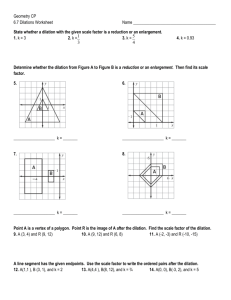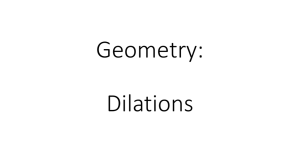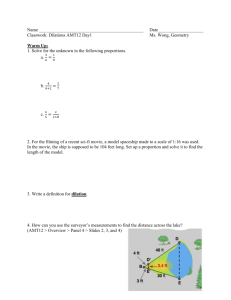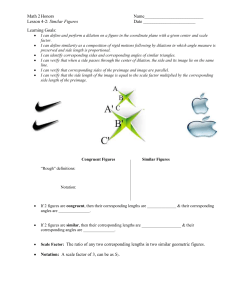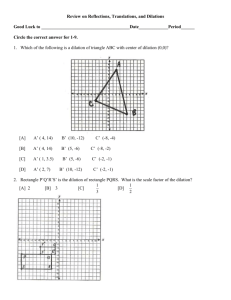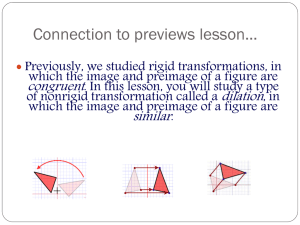Geometry notes: Dilations 1 We should start by revising scale factors
advertisement
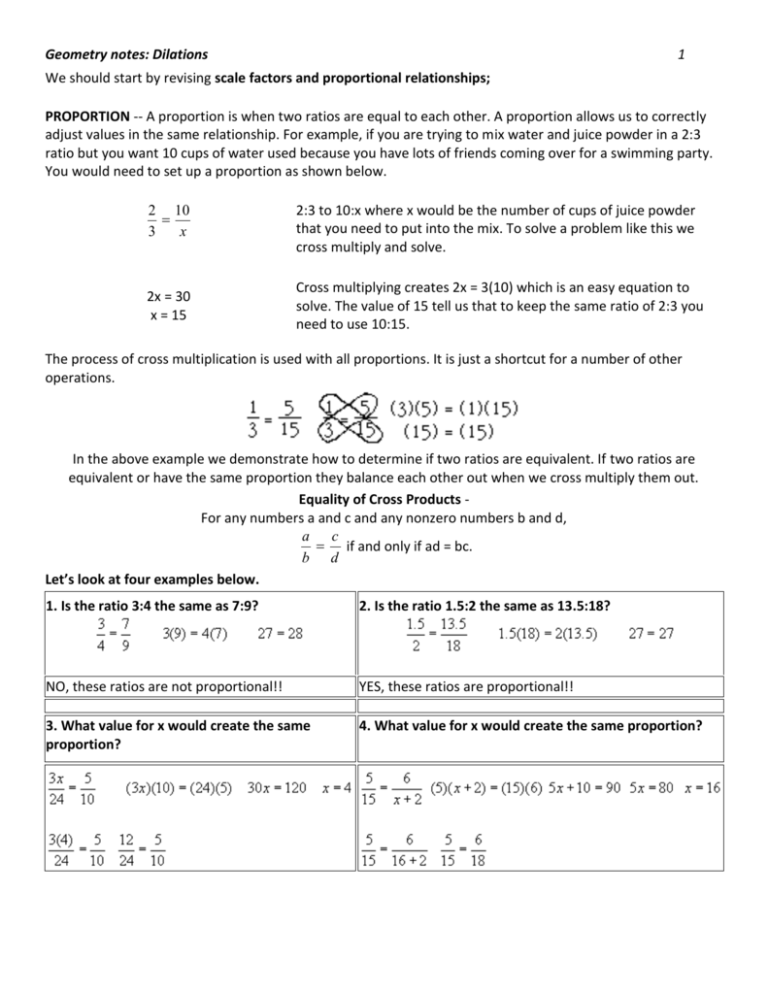
Geometry notes: Dilations 1 We should start by revising scale factors and proportional relationships; PROPORTION -- A proportion is when two ratios are equal to each other. A proportion allows us to correctly adjust values in the same relationship. For example, if you are trying to mix water and juice powder in a 2:3 ratio but you want 10 cups of water used because you have lots of friends coming over for a swimming party. You would need to set up a proportion as shown below. 2 10 3 x 2:3 to 10:x where x would be the number of cups of juice powder that you need to put into the mix. To solve a problem like this we cross multiply and solve. 2x = 30 x = 15 Cross multiplying creates 2x = 3(10) which is an easy equation to solve. The value of 15 tell us that to keep the same ratio of 2:3 you need to use 10:15. The process of cross multiplication is used with all proportions. It is just a shortcut for a number of other operations. In the above example we demonstrate how to determine if two ratios are equivalent. If two ratios are equivalent or have the same proportion they balance each other out when we cross multiply them out. Equality of Cross Products For any numbers a and c and any nonzero numbers b and d, a c if and only if ad = bc. b d Let’s look at four examples below. 1. Is the ratio 3:4 the same as 7:9? 2. Is the ratio 1.5:2 the same as 13.5:18? NO, these ratios are not proportional!! YES, these ratios are proportional!! 3. What value for x would create the same proportion? 4. What value for x would create the same proportion? Geometry notes: Dilations 2 5. Solve each proportion using cross products. 6 3 6 x x x6 5 15 21 x 2 x 1 6(x – 6) = 3x 5x = 6(15) x = 18 21 - x = 2x 21 = 3x 6x – 36 = 3x 7=x 3x = 36 x =12 We can use proportions and ratios to solve lots of different problems. Here are a few examples. 6. The ratio of boys to girls in the class is 4:3. If there are 20 boys in the class, how many girls are there? boys 4 20 girls 3 g 4g = 3(20) g = 15 There are 15 girls in the class. 7. The ratio of boys to girls in the class is 1:3. If there are 28 students in the class, how many girls are there? Method #1 Method #2 girls 3 g total 4 28 1x + 3x = 28 4g = 3(28) 4x = 28 g = 21 There are 21 girls in the class. x=7 So there are 3(7) = 21 girls in the class. 8. A triangle has angles in a ratio of 1:2:3, what is the size of each angle? 1x + 2x + 3x = 180 6x = 180 x = 30 Angles are 30:60:90 9. What are the possible names for the quadrilateral with sides 3:1:3:1? This tells us that opposite sides are equal and that all four sides are not equal…. Thus this quadrilateral could be a parallelogram or a rectangle. 10. A recipe instructs the cook to use 4 cups of water for each 3 cups of powder. If you used 10 cups of water, how much powder should be added? water 4 10 powder 3 p 4p = 3(10) p = 7.5 Add 7.5 cups of powder. Geometry notes: Dilations 3 11. The soccer club has a 3:2 of juniors to freshman. If the club has 45 students attend that are freshman and juniors, how many juniors are there? juniors 3 j total 5 45 5j = 3(45) j = 27 There are 27 juniors in the club. 12. The sides of a triangle are in the ratio of 3:8:7. If the perimeter of the triangle is 63 cm, how long is the shortest side? 3x + 8x + 7x = 63 18x = 63 x = 3.5 The smallest angle is 3(3.5) = 10.5 cm long. Do 1. Solve each proportion using cross products. a) b) c) 20 x 6 x 4 1 6 x x 15 3 x 5 15 d) 4 x2 12 2 x 13 x = _______ x = _______ x = _______ x = _______ e) f) g) h) x 1 x 1 6 x x = _______ 3 9 4 x7 x = _______ x 9 2 x 5 x = _______ x 4 5 16 x = _______ Geometry notes: Dilations 4 2. Solve the following problems. (Show work) a) The ratio of seniors to juniors in the Chess Club is 2:3. If there are 24 juniors, how many seniors are in the club? b) A 15 foot building casts a 9 foot shadow. How tall is the building that casts a 30 ft shadow at the same time c) A picture is 3 in. wide by 5 in. high was enlarged so that the width was 15 inches. How high is the enlarged picture d) Cameron has been eating 2 dollar menu burgers every week (7 days). At that rate, how many hamburgers will he in 4 weeks? e) A triangle’s three angles are in the ratio of 5:7:8. What is the measure of the smallest angle? f) A 6 foot high school boy casts a shadow of 24 inches. At the same time of day a girl at the elementary school park casts a shadow of 14 inches. How tall is she (in feet)? Geometry notes: Dilations 5 3. Solve the following problems. (Show work) a) The ratio of two supplementary angles is 4:5. Find the measures of each angle. b) The ratio of two complementary angles is 2:3. Find the measures of each angle. c) A 3 foot stick is broken into two pieces. The ratio of the two pieces is 5:7. How big are the two pieces? d) Is the largest angle acute, right or obtuse in a triangle that has angles measures in ratio, 2:3:4? e) Points A, B, C, and D are placed in alphabetical order on a line so that AB = 2BC = CD. What is the ratio BD : AD? f) Points A, B, and C are placed in alphabetical order on a line so that 3AB : AC. What is the ratio of AB : BC? g) Two numbers are in ratio 7 : 3. The sum of the two numbers is 36. What is the largest number? h) Three numbers are in the ratio of 2 : 5 : 3. If the largest number is 65. What is the smallest number? Geometry notes: Dilations 6 Activity Ratios, Proportions and Currency. One of the most applicable places where we find the use of ratios and proportions in the ‘Real World’ is in the exchanging of currency. If you have ever travelled to a foreign country you have obviously experienced currency exchanges. Currency has different values and $100 USD (United States Dollars) is not worth 100 Mexican Pecos or 100 Euros – currencies exchange at a given ratio which fluctuates daily. In the table below each currency is being compared to 1 USD. The chart below shows some countries and how they compare with our currency. The below table is from Sept. 27 th, 2013. A stronger currency to USD has a lower value than 1. A weaker currency to the USD has a higher value than 1. A equal currency to the USD has an equal value of 1. DZD AOA ARS AMD AUD BZD BWP BRL GBP BGN MMK KHR CAD CLP CNY COP CRC HRK CUP CZK DKK DOP ANG EGP AED ETB EUR XAU GTQ HTG HUF Algerian Dinar Angolan Kwanza Argentine Peso Armenian Dram Australian Dollar Belizean Dollar Botswana Pula Brazilian Real British Pound Bulgarian Lev Burmese Kyat Cambodian Riel Canadian Dollar Chilean Peso Chinese Yuan Renminbi Colombian Peso Costa Rican Colon Croatian Kuna Cuban Peso Czech Koruna Danish Krone Dominican Peso Dutch Guilder Egyptian Pound Emirati Dirham Ethiopian Birr Euro Gold Ounce Guatemalan Quetzal Haitian Gourde Hungarian Forint 81.31999969 97.61935675 5.699999809 405.6186293 1.073306858 1.959800005 8.591065039 2.25165 0.619640113 1.444485 969 4077 1.03065 503.4200134 6.1192 1916 493.6499939 5.60529995 26.5 19.0166 5.5153 42.40000153 1.769799948 6.891699791 3.672800064 18.91553099 0.739535 0.000748335 7.933000088 43.40000153 220.981 (1 of ours is worth fewer of theirs.) (1 of ours is worth more of theirs.) (1 of ours is worth the same as theirs.) ISK INR IRR IQD ILS JPY KES KWD LBP LRD LTL MKD MXN NZD KPW OMR PKR PHP XPT QAR RUB SLL XAG KRW SEK CHF SYP TRY UYU VND ZMW Icelandic Krona Indian Rupee Iranian Rial Iraqi Dinar Israeli Shekel Japanese Yen Kenyan Shilling Kuwaiti Dinar Lebanese Pound Liberian Dollar Lithuanian Litas Macedonian Denar Mexican Peso New Zealand Dollar North Korean Won Omani Rial Pakistani Rupee Philippine Peso Platinum Ounce Qatari Riyal Russian Ruble Sierra Leonean Leone Silver Ounce South Korean Won Swedish Krona Swiss Franc Syrian Pound Turkish Lira Uruguayan Peso Vietnamese Dong Zambian Kwacha 121.15 62.5025 24791 1163.4 3.5567 98.245 86.55 0.2828 1510 78.2 2.55347 45.5 13.142 1.20766 127.17 0.385 105.55 43.37 0.0007 3.6403 32.335 4280 0.04588 1075.08 6.4351 0.90588 112.95 2.0306 21.65 21112 5.31 Geometry notes: Dilations 7 1. Do the following conversions. a) How many Euro’s is the same as $1000 US Dollars? b) How many USD is the same as $512 Canadian Dollars? c) If you have 25,000 Russian Rubles, how much USD would that be? d) If you have 1,000,000 Iranian Rial, how much USD would that be? e) If you have $4,500 USD, how much Swedish Krona would that be? f) If you have $100 Burmese Kyat, how much USD would that be ? g) If you have 125,833 Algerian Dinar, what would that be in Armenian Dram? h) If you had 1,400 Gold Ounces, how much USD would you have? 2. Fill in the lists STRONGEST CURRENCIES WEAKEST CURRENCIES 1. 1. 2. 2. 3. 3. Why do you think those three currencies are so strong? Why do you think those three currencies are so weak? Geometry notes: Dilations 8 Now move onto dilations The properties and characteristics of dilations. Dilation is the term that we use quite regularly in the English language to describe the enlarging or shrinking of our pupils. Pupils dilate either larger or smaller depending on the amount of light that enters the eye. This real world example helps us to understand the use of dilation in geometry as well – dilation is a transformation that produces an image that is the same shape as the pre-image but is a different size, either larger or smaller. When we make things bigger using dilation we refer to that as an expansion or enlargement whereas if we use a dilation to make something smaller we use the term contraction or reduction. DILATION – CONTRACTION (REDUCTION) PRE-IMAGE IMAGE DILATION – EXPANSION (ENLARGEMENT) PRE-IMAGE IMAGE When the dilation is an enlargement, the scale factor is greater than 1. What this means is that if you have a scale factor of 3, or sometimes written as 3:1 (image:pre-image), the image is three times bigger proportionally to the pre-image. When the dilation is a reduction, the scale factor is between 0 and 1. What this means is that if you have a scale factor of ½, or sometimes written as 1:2 (image:pre-image), that the image is half the size proportionally to the pre-image. So what happens if the scale factor is 1? Nothing!! To multiply anything by 1 maintains the pre-image. It is like rotating a shape 360 - the shape is not altered in any way – it is an identity transformation. Q Circle whether the following situations are REDUCTIONS OR ENLARGEMENTS. a) Scale Factor of 7:1 (image : pre-image) Reduction or Enlargement b) DO ,3 ( H ) H ' B O B' c) Reduction or Enlargement Reduction or Enlargement Geometry notes: Dilations 9 DO ,1.75 ( A) A ' d) Reduction or e) Scale Factor of 2:3 (image : pre-image) Enlargement g) Reduction or f) Enlargement D O, or Enlargement i) C C' C' B O D' D' D B' D O B' B' B O B or Enlargement J) Reduction or Enlargement Reduction k) F D' C F' D E' D O O B B' B' or Enlargement C' E D' C or l) C' Reduction (G ) G ' Reduction h) C Reduction 5 3 Enlargement Reduction or Enlargement O B Reduction or Enlargement So what actually happens when a shape is dilated? B' The length of each side of the image is equal to the length of the corresponding side of the pre-image multiplied by the scale factor, A’B’ = k AB, B’C’ = k BC and A’C’ = k AC. This dilation has a scale factor of 3:1 or 3. A’B’:AB 12: 4 3:1 B’C’:BC 16.5: 5.5 3:1 A’C’: AC 15:3 3:1 12 cm 4 cm A A' B 16.5 cm 5.5 cm 5 cm 15 cm C C' Geometry notes: Dilations 10 The distance from the center of the dilation to each point of the image is equal to the distance from the center of the dilation to each corresponding point of the pre-image figure times the scale factor, OB’ = k OB and OC’ = k OC. Scale Factor 1:k ky OB = y OB’ = ky ky:y k:1 OC = x OC’ = kx kx:x k:1 B y Scale Factor of k:1 B' C O C' x kx Q Answer the following questions about the dilation, centered at O. a) Is this an enlargement or a reduction? __________________ Explain how you determined your answer. A' A b) What scale factor do you think this is? ____________ Explain how you determined your answer. O B B' c) What angle is the same size as OBA? Explain how you determined your answer. ____________ Q Answer the following questions about the dilation centered at O with a scale factor of 3. OA = 3, OB = 5 and AB = 4 a) A’B’ = _____________ A' b) OB’ = _____________ A c) OA’ = _____________ d) AA’ = _____________ (be careful) 3 O 4 5 B e) BB’ = _____________ (be careful) B' f) What is the ratio of OA:AA’? ______________ Geometry notes: Dilations 11 Activity Dilating Pictures How do I do it? Pick a number of key locations along the edge of the shape and then dilate those points by the correct scale factor. A compass can make this quite easy. Measure the distance to the pre-image point from the center of dilation and then mark the remaining lengths on the ray. So for example in the plant example below measure using your compass to a point on the pre-image and then mark two more of those lengths along the ray to get three times the pre-image length. Notice to create a scale factor of three I needed a total of three equal measure the length of the pre-image distance (the pre-image distance from the center and then two more). I have done a few points to get you started. Do enough points to finish the basic outline of the shape and then ‘rough’ in the rest. Color the final scaled copy. Geometry notes: Dilations Pick one of these two to do – (Color and detail the image). THE ANGRY SHARK (Scale Factor = 2) Cartoon Female Adventurer (Scale Factor = 2) 12 Geometry notes: Dilations 13 DEFINITION A dilation with center O and a scale factor of k is a transformation that maps every point P in the plane to point P’ so that the following properties are true. NOTATION DO ,k ( x, y ) (kx, ky ) O is the center of dilation. k is the value of the scale factor. PROPERTIES DILATION PROPERTIES - A dilation is NOT an isometric transformation so its properties differ from the ones we saw with reflection, rotation and translation. The following properties are preserved between the pre-image and its image when dilating: Angle measure (angles stay the same) Parallelism (things that were parallel are still parallel) Collinearity (points on a line, remain on the line) Distance IS NOT preserved!!! After a dilation, the pre-image and image have the same shape but not the same size. TRANSFORMATION PROPERTIES – The following properties are present in dilation: DISTANCES ARE DIFFERENT (PROPORTIONAL) – The distance points move during dilation depend on their distance from the center of dilation - points closer to the center of dilation will move a shorter distance than those farther away. In our example PP ' BB ' CC ' and point B is farther away from the P' P B' B O C C' center of dilation O than point P, thus BB ' PP ' . ORIENTATION IS THE SAME – The orientation of the shape is maintained. SPECIAL POINTS – The center of dilation is an invariant point and does not move in a dilation. If the pre-image (P) = image (P’) after a dilation then point P was the center of dilation. Geometry notes: Dilations 14 Verify experimentally the properties of dilations given by a center and a scale factor: the dilation of a line segment is longer or shorter in the ratio given by the scale factor. Scale Factor 0 < k < 1 Scale Factor k > 1 B' B B' A' B A' A A C C' C C' B 'C ' k 1 BC A 'C ' k 1 A’C’ < AC and AC A' B ' k 1 A’B’ < AB and AB B 'C ' k 1 BC A 'C ' k 1 A’C’ > AC and AC A' B ' k 1 A’B’ > AB and AB B’C’ < BC and B’C’ > BC and Examples using the coordinate rule of dilation when the center of dilation is the origin. Example #1 A dilation of 2 with center of dilation O, the origin. DO ,2 ( x, y ) (2 x, 2 y ) DO ,2 C (1,3) (2(1), 2(3)) C '(2, 6) C' (2,6) C (1,3) O (0,0) C (1,3) O (0,0) Geometry notes: Dilations 15 Example #2 A dilation of ½ with center of dilation O, the origin. D 1 O, 2 1 1 ( x , y ) ( x, y ) 1 O, 2 2 2 D D O, 1 2 1 1 A(6, 4) ( (6), ( 4)) A '(3, 2) 2 2 1 1 B(2, 8) ( (2), (8)) B '(1, 4) 2 2 O (0,0) O (0,0) A (6,-4) A' (3,-2) A (6,-4) B' (1,-4) B (2,-8) Do Worksheets: Dilation and Lines Practice Dilation Practice Thinking about Dilations B (2,-8)

